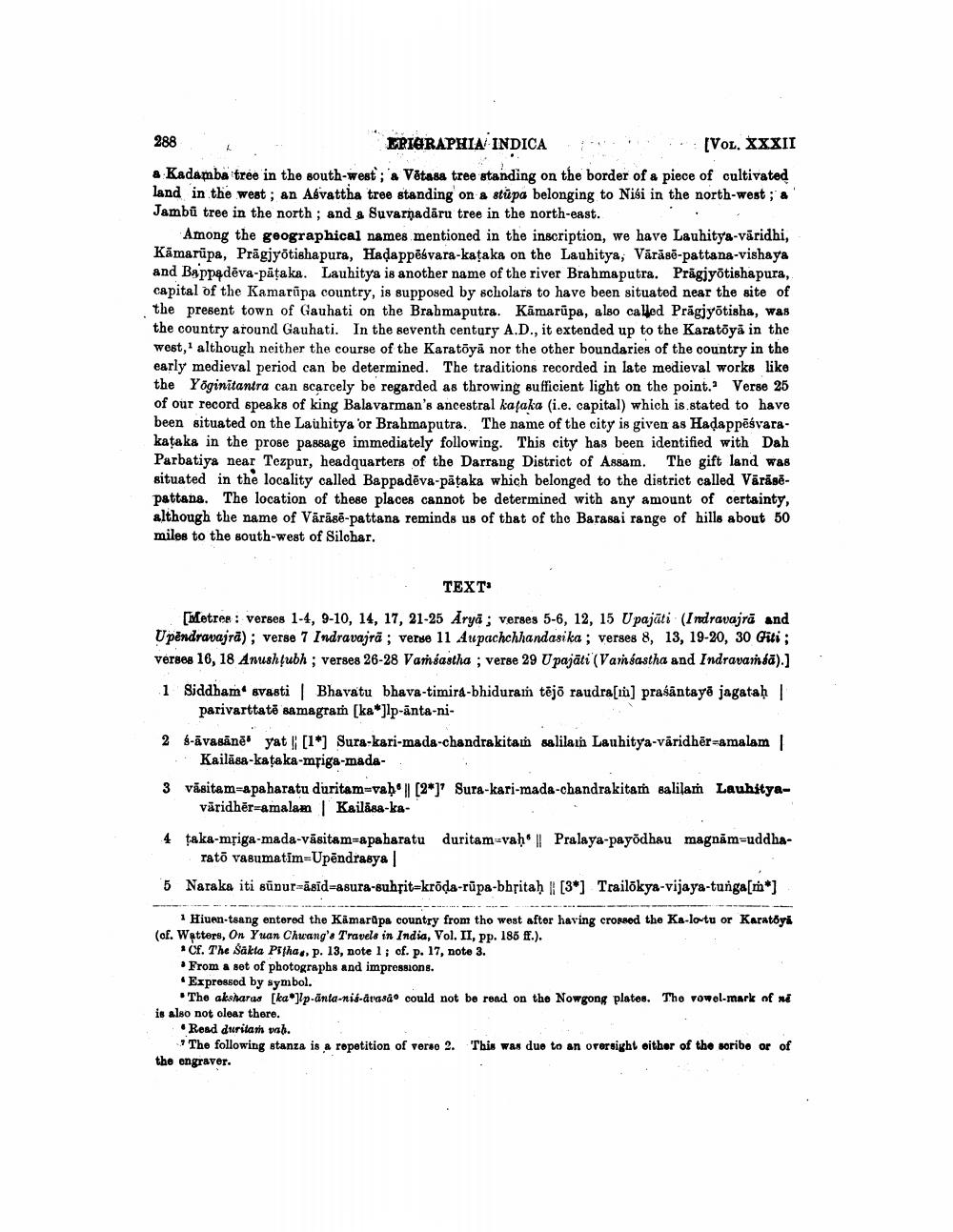________________
288
ERIGRAPHIA INDICA
[VOL. XXXII
a Kadamba tree in the south-west; a Vetasa tree standing on the border of a piece of cultivated land in the west; an Asvattha tree standing on a stupa belonging to Nisi in the north-west; Jambu tree in the north; and a Suvarnadāru tree in the north-east.
Among the geographical names mentioned in the inscription, we have Lauhitya-väridhi, Kāmarupa, Prägjyotisha pura, Haḍappēśvara-kaṭaka on the Lauhitya, Varase-pattana-vishaya and Bappadēva-pāṭaka. Lauhitya is another name of the river Brahmaputra. Pragjyōtisha pura, capital of the Kamarupa country, is supposed by scholars to have been situated near the site of the present town of Gauhati on the Brahmaputra. Kamarupa, also called Pragjyōtisha, was the country around Gauhati. In the seventh century A.D., it extended up to the Karatoya in the west, although neither the course of the Karatoya nor the other boundaries of the country in the early medieval period can be determined. The traditions recorded in late medieval works like the Yoginitantra can scarcely be regarded as throwing sufficient light on the point. Verse 25 of our record speaks of king Balavarman's ancestral kataka (i.e. capital) which is stated to have been situated on the Lauhitya 'or Brahmaputra. The name of the city is given as Haḍappēsvarakaṭaka in the prose passage immediately following. This city has been identified with Dah Parbatiya near Tezpur, headquarters of the Darrang District of Assam. The gift land was situated in the locality called Bappadeva-pāṭaka which belonged to the district called Vārāsēpattana. The location of these places cannot be determined with any amount of certainty, although the name of Väräse-pattana reminds us of that of the Barasai range of hills about 50 miles to the south-west of Silchar.
TEXT'
[Metres: verses 1-4, 9-10, 14, 17, 21-25 Arya; verses 5-6, 12, 15 Upajāti (Indravajrā and Upendravajra); verse 7 Indravajra; verse 11 Aupachchhandasika; verses 8, 13, 19-20, 30 Giti; verses 16, 18 Anushṭubh; verses 26-28 Vamsastha; verse 29 Upajati (Vamsastha and Indravaṁśā).] 1 Siddham svasti | Bhavatu bhava-timira-bhiduram tējo raudra[m] prasantayē jagataḥ | parivarttatē samagram [ka*]lp-anta-ni
2 -āvasānē yat | [1] Sura-kari-mada-chandrakitam salilam Lauhitya-varidhēr=amalam | Kailasa-kataka-mriga-mada
3 väsitam-apaharatu duritam-vaḥ || [2*] Sura-kari-mada-chandrakitam salilam Lauhityaväridhĕr-amalam | Kailasa-ka
4 taka-mriga-mada-väsitam-apaharatu duritam vaḥ | Pralaya-payōdhau magnām=uddharato vasumatim-Upendrasya |
5 Naraka iti sunur asid-asura-suhrit-kröda-rupa-bhritaḥ [3] Trailōkya-vijaya-tunga[m*]
1 Hiuen-tsang entered the Kamarupa country from the west after having crossed the Ka-lo-tu or Karatōyi (of. Watters, On Yuan Chuang's Travels in India, Vol. II, pp. 185 ff.).
Cf. The Sakta Pithas, p. 13, note 1; cf. p. 17, note 3.
From a set of photographs and impressions.
Expressed by symbol.
The aksharas [ka*]lp-ānta-niś-āvasāo could not be read on the Nowgong plates. The vowel-mark of në is also not clear there.
Read duritam vab.
"The following stanza is a repetition of verse 2. This was due to an oversight either of the scribe or of the engraver.




